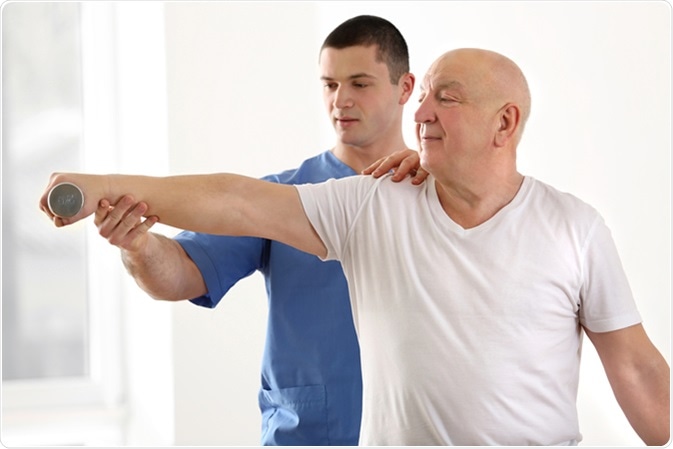Physiotherapy as a Treatment for Arthritis
Physiotherapy (PT) is a type of healthcare profession, which focuses on establishing the mobility and functioning of affected body parts by applying various techniques such as manual therapy, hydrotherapy, and electrotherapy along with patient advice and counseling.

Introduction
Arthritis is a disease that affects the joints connecting the bones. It can manifest in both acute and chronic forms and is associated with inflammation of the joints. The patients with arthritis experience pain, stiffness, and discomfort during mobility. Arthritis has two major forms: osteoarthritis that occurs when the cartilages between joints are damaged; and rheumatoid arthritis, an autoimmune disease that occurs when body’s immune system affects its own joints.
The main objective of PT in treating arthritis involves improving the mobility and re-establishing the functioning of affected joints. Physiotherapists are licensed professionals who strengthen affected joints by employing various therapies.
Role of Physiotherapy in treating Osteoarthritis
Osteoarthritis mainly affects knee joints, hips, spine, and fingers. PT is recommended in patients suffering from osteoarthritis because it benefits the patients by improving physical functioning and reducing pain.
Various modalities utilized by physiotherapists for treating osteoarthritis include:
- Exercises
- Massages
- Providing patients with walking aids
- Electrotherapy
Physiotherapy as a treatment approach in Knee Osteoarthritis includes:
- Hydrotherapy: It utilizes water to treat arthritis. Specialized exercises are performed inside water with a temperature range of 33-36 °C . Physiotherapists guide the patients with specific exercises such as stretching, aerobics, and strengthening exercises.
- Manual therapy is another approach wherein physiotherapists use hands-on techniques to relieve pain and stiffness.This technique has shown immense benefits in treating knee osteoarthritis.
- Other approaches such as acupuncture (dry needling) and thermotherapy have also shown great benefits in relieving pain.
Physiotherapy as a treatment approach in Hip Osteoarthritis:
Hip joint bears the body weight; thus, pain in this joint affects the overall mobility. PT aims to improve the mobility in patients in such cases. Techniques used by physiotherapists include:
- Manual therapy
- Stretching and strengthening exercises
- Weight management training
- Hip Joint protection strategies: This technique involves guiding the patient about certain joint protection methods. Patients are mainly adviced against carrying heavy weights and doing certain activities that overload the joint. They are also provided with gait aids and are advised to use appropriate foot wares. Physiotherapists also teach them about maintaining a correct posture.
Role of Physiotherapy in treating Rheumatoid Arthritis (RA)
Physiotherapists usually perform a physical assessment test before starting the treatment. The assessment majorly involves evaluation of the gait, daily life activities, range of joint motion, muscle strength test, posture, and respiratory function. Afterwards, they use the arthritis impact measurement scale I & II and health assessment questionnaire for a precise assessment.
Physiotherapy Modalities in treating Rheumatoid Arthritis
This form of treatment approach majorly involves the below-mentioned techniques:
- Hot/cold applications- Hot/Cold therapy is used in both acute and chronic conditions of RA. Cold packs are usually applied in patients suffering from acute conditions, and hot therapy is applied at chronic stage of RA. Hot packs are usually applied for 10-20 mins once or twice daily. For cold therapy , application modalities are cold packs, ice, nitrogen spray, and cryotherapy.
- Electrical Stimulation-Transcutaneous electrical nerve stimulation (TENS) therapy is the most common form of electrotherapy used to treat RA. Studies have reported that patients experience less pain after recieving TENS therapy once a week for approximately a month.
- Hydrotherapy-Patients get relief from RA if hydrotherapy is performed at regular intervals.This technique provides palliative treatment in case of acute and chronic conditions.
Rehabilitation techniques in treating RA majorly involve splinting of the affected joints, use of compression gloves, manual therapy, therapeutic exercises, and patient education.
Conclusion
Hence, it can be concluded that patients suffering from arthritis can get immense relief upon consulting a physiotherapist . Advancements are continually being made in the area of PT to improve the quality of life in patients affected with arthritis.
Reviewed by Sanchari Sinha Dutta, PhD
Sources
- https://www.ncbi.nlm.nih.gov/pmc/articles/PMC1395797/
- www.journalofphysiotherapy.com/article/S1836-9553(13)70179-6/pdf
- https://www.ncbi.nlm.nih.gov/pubmed/21518313
- https://www.ncbi.nlm.nih.gov/pubmed/21518313
- www.arthritisresearchuk.org/…/how-can-it-help.aspx
- www.arthritis.org/…/what-is-physical-therapy.php
Further Reading
- All Arthritis Content
- What is Arthritis?
- Types of Arthritis
- Arthritis Treatment
- Arthritis History
Last Updated: Aug 23, 2018

Written by
Akshima Sahi
Akshima is a registered dentist and seasoned medical writer from Dharamshala, India. Akshima is actively involved in educating people about the importance of good dental health. She examines patients and lends free counseling sessions. Taking her passion for medical writing ahead, her aim is to educate the masses about the value of good oral health.
Source: Read Full Article
